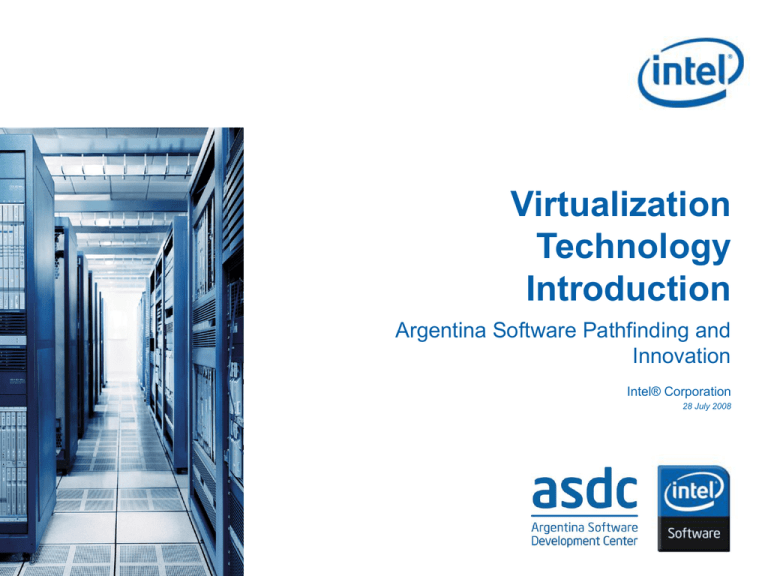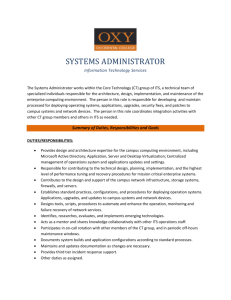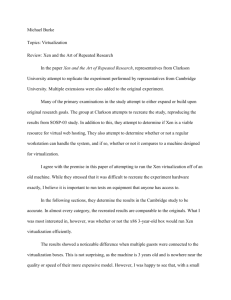Virtualization
advertisement

Virtualization Technology Introduction Argentina Software Pathfinding and Innovation Intel® Corporation 28 July 2008 Introduction Why is Intel giving this course? Argentina Software Development Center in Córdoba - Strong investment in developing areas of expertise Software Pathfinding and Innovation - Seeking the next technological move Strategic Area in Virtualization Technology - Evolving expertise in Virtualization Technology - Augment critical mass in this area Introduction What are your expectations from this course? - Learn about virtualization technology Academia research - Research in grids, cloud… - - Planning in participate in an Open Source community from virtualization Business - Using virtualization in my datacenter - Planning to use it - ? Introduction How is this course? Goal: - Foster virtualization technology, its usages, its capabilities and explore possible research and study projects Audience: - Beginners: provide a guide to start working/researching in Virtualization Technologies - Advanced: solidify concepts and go deep in VMM cases and Hardware assisted Virtualization Course Structure: - Virtualization Technology Introduction - Usages of Virtualization - VMMs / Hypervisors - Hardware Assisted Virtualization - Virtualization Technology Trends Agenda • • • • Introduction Virtualization yesterday – virtualization today Challenges for x86 virtualization Approaches to server virtualization – Host-based server virtualization • Full Virtualization • Para-virtualization • Hardware-assisted Virtualization • Approaches to desktop virtualization Introduction What is virtualization? Virtualization is a broad term (virtual memory, storage, network, etc) Focus for this course: platform virtualization Virtualization basically allows one computer to do the job of multiple computers, by sharing the resources of a single hardware across multiple environments Virtual Virtual Container App. A App. B App. C App. D App. A App. B Container App. C App. D Operating System Virtualization Layer Hardware Hardware ‘Nonvirtualized’ system A single OS controls all hardware platform resources Virtualized system It makes it possible to run multiple Virtual Containers on a single physical platform Introduction Virtualization Requirements Popek and Goldberg describe in their “Formal Requirements for Virtualizable Third Generation Architectures – 1974”: • A Model of Third Generation Machines – Machine states: S = (E, M, P, R) – Instructions classification • Privileged instructions • Control sensitive instructions • Behavior sensitive instructions • Properties for a Virtual Machine Monitor – Equivalence – Resource control – Efficiency • Formal analysis described through 2 theorems Introduction The VMM and the VM Equivalence Resource Control Efficiency Privileged instructions Control sensitive Behavior sensitive • • For any conventional third generation computer, a VMM may be constructed if the set of sensitive instructions for that computer is a subset of the set of privileged instructions A conventional third generation computer is recursively virtualizable if it is virtualizable and a VMM without any timing dependencies can be constructed for it. The evolution of virtualization Evolution of Virtualization How did it start? • Server virtualization has existed for several decades – IBM pioneered more than 30 years ago with the capability to “multitask” • The inception was in specialized, proprietary, high-end server and mainframe systems • By 1980/90 servers virtualization adoption initiated a reduction – Inexpensive x86 hardware platforms – Windows/Linux adopted as server OSs Evolution of Virtualization Computing Infrastructure – 2000 • 1 machine 1 OS several applications • Applications can affect each other • Big disadvantage: machine utilization is very low, most of the times it is below than 25% App App App App App App App App X86 Windows XP X86 Windows 2003 X86 Suse X86 Red Hat 12% Hardware Utilization 15% Hardware Utilization 18% Hardware Utilization 10% Hardware Utilization Evolution of Virtualization Virtualization again… x86 server deployments introduced new IT challenges: • Low server infrastructure utilization (10-18%) • Increasing physical infrastructure costs (facilities, power, cooling, etc) • Increasing IT management costs (configuration, deployment, updates, etc) • Insufficient failover and disaster protection The solution for all these problems was to virtualize x86 platforms Evolution of Virtualization Computing Infrastructure - Virtualization • It matches the benefits of high hardware utilization with running several operating systems (applications) in separated virtualized environments – Each application runs in its own operating system – Each operating system does not know it is sharing the underlying hardware with others App. A App. B App. C App. D X86 Windows XP X86 Windows 2003 X86 Suse Linux X86 Red Hat Linux X86 Multi-Core, Multi Processor 70% Hardware Utilization Challenges for x86 virtualization x86 virtualization challenge Challenges of x86 virtualization • The IA-32 instruction set contains 17 sensitive, unprivileged instructions: – Sensitive register instructions: read or change sensitive registers and/or memory locations such as a clock register or interrupt registers: • SGDT, SIDT, SLDT, SMSW, PUSHF, POPF – Protection system instructions: reference the storage protection system, memory or address relocation system: • LAR, LSL, VERR, VERW, POP, PUSH, CALL, JMP, INT n, RET, STR, MOV • However, x86 is a really big candidate to be virtualized, mainly for business facts x86 modes: Privilege Levels Challenges of x86 virtualization • x86 processor’s segment-protection mechanism recognizes 4 privilege levels (0-high, 3-low level) unused • Recognizes the following three types of privilege levels: – Current privilege level (CPL) – Descriptor privilege level (DPL) – Requested privilege level (RPL) Challenges of x86 virtualization x86 virtualization challenge example: reading Segment Descriptors – x86 Code Segment and Stack Segment registers: • The upper 14 bits of these registers contain the segment index and descriptor table selector. • Lower 2 bits of CS and SS registers contains the CPL (Current Privilege Level). – Instructions that explicitly or implicitly access the CS/SS selector (including CALL, MOV from SS and POP SS) do not trap when executed from user mode. Executing POP SS the guest OS will be aware that it is not running on a privileged level when in ring 1 The Equivalence Property could be violated The Resource Control property is violated Challenges of x86 virtualization X86 virtualization challenge example: reading Segment Descriptors (segment details) Challenges of x86 virtualization x86 virtualization challenge example (2) • GDT, LDT, IDT and TR: – For correct virtualization, these tables should be “shadowing” (the TR, GDTR, IDTR registers should point to VMM’s shadow tables) – Non privileged code can read from these registers (that means that reading these registers do not trap) The Equivalence Property could be violated • Table 2-2. Summary of System Instructions - Software Developer’s Manual Vol 3A Approaches to server virtualization Evolution of Software solutions • 1st Generation: Full • 2nd Generation: virtualization Paravirtualizatio (Binary rewriting) n – Software Based – VMware and Microsoft Virtual Machine Virtual … Machine – Cooperative virtualization – Modified guest – VMware, Xen VM Dynamic Translation … Server virtualization approaches • 3rd Generation: Silicon-based (Hardware-assisted) virtualization – Unmodified guest – VMware and Xen on virtualization-aware hardware platforms VM Virtual Machine Virtual … Machine Operating System Hypervisor Hypervisor Hardware Hardware Hardware Time Virtualization Logic • All of the hardware is emulated including the CPU • Two popular open source emulators are QEMU and Bochs App. A App. B Guest OS – The emulation layer talks to an operating system which talks to the computer hardware – The guest OS doesn't see that it is used in an emulated environment Virtual Machine • 1st Generation offering of x86/x64 server virtualization • Dynamic binary translation App. C Full Virtualization Server virtualization approaches Device Drivers Emulated Hardware Device Drivers Host OS Hardware Full Virtualization - Advantages Server virtualization approaches • The emulation layer – Isolates VMs from the host OS and from each other – Controls individual VM access to system resources, preventing an unstable VM from impacting system performance • Total VM portability – By emulating a consistent set of system hardware, VMs have the ability to transparently move between hosts with dissimilar hardware without any problems • It is possible to run an operating system that was developed for another architecture on your own architecture • A VM running on a Dell server can be relocated to a HewlettPackard server Full Virtualization - Drawbacks Server virtualization approaches • Hardware emulation comes with a performance price • In traditional x86 architectures, OS kernels expect to run privileged code in Ring 0 – However, because Ring 0 is controlled by the host OS, VMs are forced to execute at Ring 1/3, which requires the VMM to trap and emulate instructions • Due to these performance limitations, paravirtualization and hardware-assisted virtualization were developed Application Application Operating System Ring 3 Ring 0 Traditional x86 Architecture Ring 3 Guest OS Ring 1 / 3 Virtual Machine Monitor Ring 0 Full Virtualization • The VMM is responsible for handling the virtualization requests and putting them to the hardware App. A Guest OS – the guest is fully aware of how to process privileged instructions – thus, privileged instruction translation by the VMM is no longer necessary – The guest operating system uses a specialized API to talk to the VMM and, in this way, execute the privileged instructions Virtual Machine • The Guest OS is modified and thus run kernel-level operations at Ring 1 (or 3) App. B Para-Virtualization App. C Server virtualization approaches Device Drivers Specialized API Virtual Machine Monitor Device Drivers Hypervisor Hardware Para-Virtualization • Server virtualization approaches Today, VM guest operating systems are paravirtualized using two different approaches: – Recompiling the OS kernel • Paravirtualization drivers and APIs must reside in the guest operating system kernel • You do need a modified operating system that includes this specific API, requiring a compiling operating systems to be virtualization aware – Some vendors (such as Novell) have embraced paravirtualization and have provided paravirtualized OS builds, while other vendors (such as Microsoft) have not – Installing paravirtualized drivers • In some operating systems it is not possible to use complete paravirtualization, as it requires a specialized version of the operating system • To ensure good performance in such environments, paravirtualization can be applied for individual devices • For example, the instructions generated by network boards or graphical interface cards can be modified before they leave the virtualized machine by using paravirtualized drivers App. A App. B Guest OS Virtual Machine • The guest OS runs at ring 0 • The VMM uses processor extensions (such as Intel®-VT or AMD-V) to intercept and emulate privileged operations in the guest • Hardware-assisted virtualization removes many of the problems that make writing a VMM a challenge • The VMM runs in a more privileged ring than 0, a virtual -1 ring is created App. C Hardware-assisted virtualization Server virtualization approaches Device Drivers Specialized API Virtual Machine Monitor Device Drivers Hypervisor Hardware Server virtualization approaches Hardware-assisted virtualization • The hypervisor/VMM runs at Ring -1 – super-privileged mode VMX non-root VMX root Hardware-assisted virtualization Server virtualization approaches • Pros – It allows to run unmodified Oss (so legacy OS can be run without problems) • Cons – Speed and Flexibility • An unmodified OS does not know it is running in a virtualized environment and so, it can’t take advantage of any of the virtualization features – It can be resolved using paravirtualization partially Approaches to desktop virtualization Client virtualization approaches Extending the concept of virtualization for desktops • Servers – Hosted virtualization - mainframes – VMMs / Bare Metal hypervisors – OS virtualization • Desktops – Desktop virtualization – Server-side workspace virtualization – Client-side workspace virtualization • Application virtualization – Application isolation – Application streaming Desktop Virtualization • • A VMM or hypervisor running on a physical desktop Examples include: – – – – • Use cases include: – – – • Microsoft Virtual PC Parallels Desktop for Mac VMware Fusion WINE. Emulating Windows games on the Macintosh, Testing code inside VMs Underpinning client-side workspace virtualization Desktop hypervisors and VMMs don’t necessarily scale to meet enterprise needs; that’s why most of the providers have server products as well Desktop virtualization approaches Server-side workspace virtualization • • A workspace (desktop operating system with custom configuration) running inside a virtual machine hosted on a server Examples include: – • Use cases include: – – • • • • VMware VDI Centrally managed desktop infrastructure Security enforcement and lockdown A pool of virtual workspaces resides on the server. Remote users log into them from any networked device via Microsoft’s Remote Desktop Protocol (RDP) Users can customize their virtual workspace to their heart’s content, while operators enjoy the relatively straightforward task of managing desktop configuration on one central server Connection brokers arbitrate between a pool of virtual workspaces residing on a central server The biggest problem with server-hosted workspace virtualization is that it’s a bandwidth hog. Performance is constrained by the performance of your network Desktop virtualization approaches Client-side workspace virtualization • • A workspace (desktop operating system with custom configuration) running inside a virtual machine hosted on a desktop Examples include: – – • Use cases include: – – – • • • • Kidaro Managed Workspace Sentillion vThere Secure remote access Protection of sensitive data for defense, healthcare industries Personal computer running corporate desktops remotely A virtual workspace is served out to execute on the client device Centralizes management Its big advantage over other models is the security and isolation of data and logic on the client It’s the right model for organizations that need to ensure the security of environments served to remote users – – Defense contractors Healthcare providers Desktop virtualization approaches Application Isolation • • An application packaged with its own virtual copies of the operating system resources it might otherwise need to change (registries, file systems, libraries) Examples include: – – • Use cases include: – – • Preventing DLL hell Sandboxing desktop applications for secure execution Applications use a virtual registry (Thinstall) and file system embedded in the package with the application – • • Thinstall Trigence These extra tools insulate applications from changes to and incompatibility with the underlying desktop operating system Mostly in Windows, although Linux and Solaris as well Drawback: increased footprint of the application package and the correspondingly greater memory requirements Desktop virtualization approaches Application Streaming • • Just-in-time delivery of a server-hosted application to the desktop, such that the desktop application can execute before the entire file has been downloaded from the server Examples include: – – • Use cases include: – • Managing the number of instances of running applications, in the case of license constraints Superset of Application Isolation, including a delivery method and an execution mode – • AppStream Microsoft SoftGrid You stream the application code to the desktop, where it runs in isolation No full PC environment, just the application, so you have to provide a workspace – Requires to maintain the client-side operating system and ensuring compatibility. This may be why application streaming, which has been around for a long time (AppStream has already raised over $50m in venture capital), has not really lived up to its early hype. Desktop virtualization approaches Periodic table of Virtualization Extracted from Virtualization II: Desktops and applications are next – the 451 group Day wrap-up • Requirements for HW Architecture Virtualization – Popek and Goldberg • Evolution for virtualization: from mainframes to x86 architecture due to business reasons • Challenges around x86 virtualization -> ISA doesn’t comply with P&G • Server virtualization approaches – Full Virtualization – Paravirtualization – Hardware Assisted Virtualization • Client virtualization approaches – Desktop virtualization – Server-side workspace virtualization – Client-side workspace virtualization • Application virtualization – Application isolation – Application streaming Questions? Backup References • • • • • • http://en.wikipedia.org/wiki/Platform_virtualization http://en.wikipedia.org/wiki/Popek_and_Goldberg_virtualization_requirements http://www.vmware.com/virtualization/ http://www.vmware.com/overview/history.html Formal Requirements for Virtualizable Third Generation Architectures – 1974 Popek (UCLA) and Goldberg (Honeywell Information Systems and Harvard University) Virtualization II: Desktops and applications are next – the 451 group Contacts Argentina Software Pathfinding and Innovation team from Virtualization Technology: • Guillermo Colsani: guillermo.e.colsani@intel.com • Gisela Giusti: gisela.giusti@intel.com • Pablo Pássera: pablo.r.passera@intel.com • Duilio Protti: duilio.j.protti@intel.com





